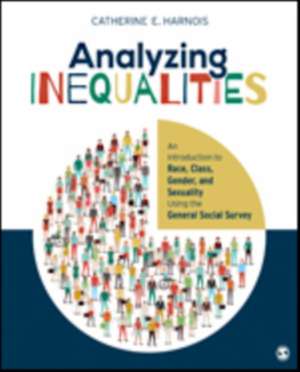Analyzing Inequalities: An Introduction to Race, Class, Gender, and Sexuality Using the General Social Survey
Autor Catherine E. Harnoisen Limba Engleză Paperback – 23 apr 2017
- introduces readers to the GSS, one of the most widely analyzed surveys in the U.S.
- examines a range of GSS questions related to social inequalities
- demonstrates basic techniques for analyzing this data online.
Preț: 410.71 lei
Preț vechi: 446.42 lei
-8% Nou
78.59€ • 81.08$ • 65.58£
Carte tipărită la comandă
Livrare economică 27 martie-10 aprilie
Specificații
ISBN-10: 1506304117
Pagini: 232
Dimensiuni: 187 x 232 x 14 mm
Greutate: 0.39 kg
Ediția:1
Editura: SAGE Publications
Colecția Sage Publications, Inc
Locul publicării:Thousand Oaks, United States
Recenzii
“[It] include[s] basic research analysis principles and very good examples and applications [and] also manages to provide critical and progressive conceptual perspectives.”
“Grounding sociological theory in real-world examples using real sociological data is an absolutely important aspect of undergraduate exposure to the scientific method and sociological analysis.”
Cuprins
Introduction: An Introduction to Analyzing inequalities
Social Justice Statistics
Social Justice Statistics: Critiques and Limitations
Chapter 2: Understanding Data – Critical Concepts
Overview of the GSS
Finding data in the GSS
Producing and Interpreting a Frequency Table
Describing Variables: levels of measurement
Describing Variables: Measures of Central Tendency
Producing the Mean, Median and Mode in SDA
Chapter 3: Analyzing Gender with the GSS
Introduction: Key concepts in gender
Identifying variables related to gender
Produce and Interpret a Bivariate Table or “Crosstab”
Chapter 4: Analyzing Race and Ethnicity with the GSS
Introduction: Key Concepts in Race and Ethnicity
Identifying variables related to race and ethnicity
Produce and Interpret a Bivariate Table or “Crosstab”
Applying a Filter
Applying Control variables
Chapter 5: Analyzing Class with the GSS
Introduction: Key Concepts in Social Class.
Identifying variables related to socio-economic class
Re-coding Variables
Comparing the Mean Response for Different Groups
Chapter 6: Analyzing Sexuality with the GSS
Introduction: Key concepts in Sexuality
Identifying Variables related to Sexuality
Applying a Filter
Re-coding Variables
Chapter 7: Analyzing Inequalities in Families
Introduction: Family change and family diversity
Identifying variables related to Families
Chapter 8: Analyzing Inequalities in Education
Introduction: Inequalities in Education
Identifying variables related to Education
Analyzing Inequalities related to Education
Chapter 9: Analyzing Inequalities in the Economy and Work
Introduction: Inequalities in the Economy and at Work
Identifying variables related to Work and the Economy
Notă biografică
Catherine E. Harnois is Professor and Chair of the Department of Sociology at Wake Forest University, where she teaches courses on social inequality and research methods. She is the author of two books: Feminist Measures in Survey Research (SAGE 2013) and Analyzing Inequalities: An Introduction to Race, Class, Gender & Sexuality Using the US General Social Survey (SAGE, 2018). Her current research uses an intersectional framework to investigate issues of political consciousness, identity, and discrimination. Her methodological work on the intersection of gender and racial discrimination received the 2012 Outstanding Contribution to Scholarship Article Award from the American Sociological Association Section on Race, Gender, and Class. Her research has appeared in the journals Gender & Society, Ethnic and Racial Studies, Social Psychology Quarterly, Journal of Health and Social Behavior, Social Science & Medicine, and other scholarly outlets.















